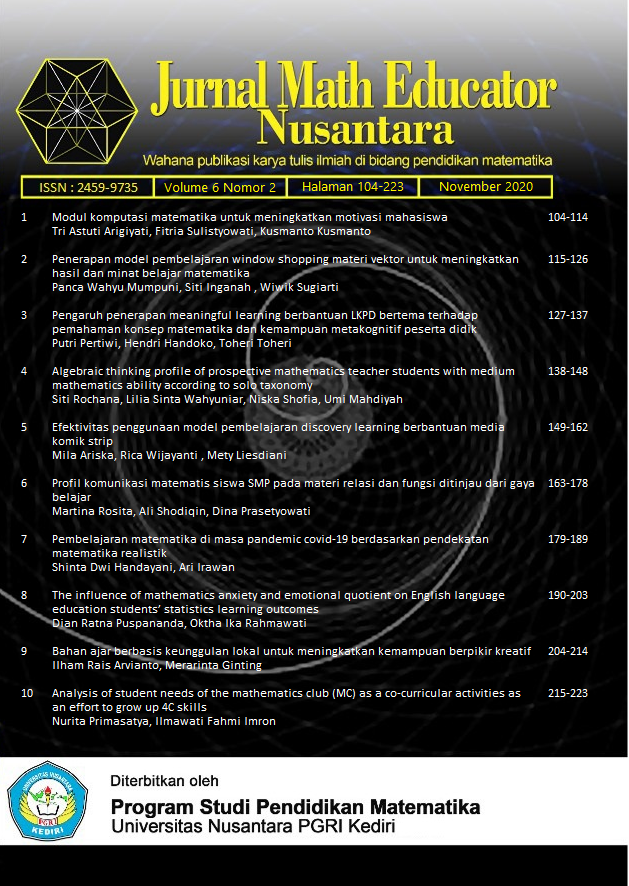Profil komunikasi matematis siswa SMP pada materi relasi dan fungsi ditinjau dari gaya belajar
DOI:
https://doi.org/10.29407/jmen.v6i2.14855Keywords:
mathematical communication;,learning style;relation and function.Abstract
This research aims to know the profile junior high school students mathematics communication viewed from the learning style of the material relations and functions. This research is descriptive qualitative research. Research subject are 6 students of grade VIII MTs. Muhammadiyah Kajen with visual learning style, auditory learning style and kinesthetic learning style. Data collection techniques in the form of written tests and interview. Data validity using triangulation method that is by comparing the results of the written and interview. From the reseach obtained by students with visual learning style can be all indicators of the mathematical communications that is expressing daily events into mathematical language or symbols,explain an idea,situations and mathematical relations with real objects, picture,graphs and algebra,states the situation in the form of an image and compile mathematical model and solve it,states the image in plain language form (arrange story problems) and expressing arguments and reading with the understanding of written mathematical presentation and draw conclutions.Students with an auditory learning style can satisfy the indicators of expressing daily events into mathematical language or symbols, explain an idea, situations and mathematical relations with real objects, picture,graphs and algebra,states the situation in the form of image and compile mathematical model and solve it,and reading with the understanding of written mathematical presentation and draw conclutions. Students with kinesthetic learning style are able to expressing daily events into mathematical language or symbols,reading with the understanding of written mathematical presentation and draw conclutions.
References
Arifin, Z. (2011). Penelitian Pendidikan Metode dan Paradigma Baru. Bandung: PT Remaja Rosdakarya.
Bire,A. L., Geradus, U., & Bire, J. (2014). Pengaruh Gaya Belajar Visual, Auditorial, Dan Kinestetik Terhadap Prestasi Belajar Siswa..Jurnal Kependidikan: Penelitian Inovasi Pembelajaran, 44(2). https://doi.org/10.21831/jk.v44i2.5307
Budiarti, I., & Jabar, A. (2016). Pengaruh gaya belajar terhadap hasil belajar matematika siswa kelas VIII SMPN 2 Banjarmasin tahun ajaran 2015/2016. Math Didactic: Jurnal Pendidikan Matematika, 2(3), 142–147. https://doi.org/10.33654/math.v2i3.42
Danaryanti, A., & Noviani, H. (2015). Pengaruh Gaya Belajar Matematika Siswa Kelas VII terhadap Kemampuan Komunikasi Matematis di SMP. EDU-MAT: Jurnal Pendidikan Matematika, 3(2), 204–212. https://doi.org/10.20527/edumat.v3i2.648
De Porter, B., & Hernacki, M. (2000). Quantum Learning. Bandung :Kaifa.
Fahradina, N., Ansari, B. I., & Saiman. (2014). Peningkatan kemampuan komunikasi matematis dan kemandirian belajar siswa smp dengan menggunakan model investigasi kelompok. Jurnal Didaktik Matematika, 1(2).
Hendriana, H., Rohaeti, E. E., & Sumarmo, U. (2017). Hard Skills dan Soft Skills Matematik Siswa. Bandung :Refika Aditama.
Indrayany, E. S., Andriani, D. G., & Tyas, R. (2018). Pengaruh Strategi Pembelajaran Aktif Firing Line Terhadap Komunikasi Matematika pada Pokok Bahasan Kubus dan Balok Kelas VIII A SMP PGRI 1 Panggul Tahun Pelajaran 2017/2018. Jurnal Math Educator Nusantara: Wahana Publikasi Karya Tulis Ilmiah Di Bidang Pendidikan Matematika, 4(1), 51-56. https://doi.org/10.29407/jmen.v4i01.11995
Khairunnisa. (2018). Analisis Kemampuan Komunikasi Matematis Ditinjau dari Gaya Belajar Siswa Kelas VIII MTs. Islamiyah Urung Pane.Skripsi: Universitas Islam Negeri Sumatera Utara.
Mahmudi, A. (2009). Komunikasi dalam Pembelajaran Matematika. Jurnal MIPMIPA UNHALU, 8(1), 9.
Maudi, N. (2016). Implementasi Model Project Based Learning Untuk Meningkatkan Kemampuan Komunikasi Matematis Siswa. JPMI (Jurnal Pendidikan Matematika Indonesia), 1(1), 39.
Nasution, D. P., & Ahmad, M. (2018). Penerapan Pembelajaran Matematika Realistik untuk Meningkatkan Kemampuan Komunikasi Matematis Siswa. Mosharafa: Jurnal Pendidikan Matematika, 7(3), 389–400. https://doi.org/10.31980/mosharafa.v7i3.133
Noer, S. H., & Gunowibowo, P. (2018). Efektivitas Problem Based Learning ditinjau dari Kemampuan Berpikir Kritis Dan Representasi Matematis. Jurnal Penelitian Dan Pembelajaran Matematika, 11(2). https://doi.org/10.30870/jppm.v11i2.3751
Nuraeni, R., & Luritawaty, I. P. (2018). Mengembangkan Kemampuan Komunikasi Matematik Siswa melalui Strategi Think Talk Write. Mosharafa: Jurnal Pendidikan Matematika, 5(2), 101–112. https://doi.org/10.31980/mosharafa.v5i2.265
Nurbayani, Y & Nanang, N. (2013). Perbedaan Kemampuan Komunikasi Matematik Siswa Antara Yang Mendapatkan Pembelajaran Kooperatif Tipe Numbered Heads Together Dengan Student Teams Achievement Division. Mosharafa :Jurnal Pendidikan Matematika, 2(September), 203–212.
Permendiknas. (2006). Peraturan Menteri Pendidikan Nasional No. 22 tentang Standar Isi untuk Satuan Pendidikan Dasar dan Menengah. Jakarta:Depdiknas
Sari, I. P. (2017). Kemampuan Komunikasi Matematika Berdasarkan Perbedaan Gaya Belajar Siswa Kelas X SMA Negeri 6 Wajo Pada Materi Statistika. Jurnal Nalar Pendidikan, 5(2), 86–92.
Shodiqin, A., Waluya, S. B., Rochmad, & Wardono. (2020). Mathematics communication ability in statistica materials based on reflective cognitive style. Journal of Physics: Conference Series, 1511(1). https://doi.org/10.1088/1742-6596/1511/1/012090
Sugiyono. (2016). Metode Penelitian Kuantitatif, Kualitatif, dan R&D. Bandung :Alfabeta.
Widyawati, S. (2016). Pengaruh Gaya Belajar Terhadap Prestasi Belajar Mahasiswa Program Studi Pendidikan Matematika (IAIM NU) Metro. Jurnal Pendidikan Matematika, 7(1), 107–114.
Wijayanti, I. D., Hariastuti, R. M., & Yusuf, F. I. (2019). Kemampuan Komunikasi Matematis Siswa Ditinjau Dari Gaya Belajar. Jurnal INDIKTIKA,2(1), 68–76.
Downloads
Published
Issue
Section
License
Authors who publish with this journal agree to the following terms:
- Copyright on any article is retained by the author(s).
- The author grants the journal, the right of first publication with the work simultaneously licensed under a Creative Commons Attribution License that allows others to share the work with an acknowledgment of the work’s authorship and initial publication in this journal.
- Authors are able to enter into separate, additional contractual arrangements for the non-exclusive distribution of the journal’s published version of the work (e.g., post it to an institutional repository or publish it in a book), with an acknowledgment of its initial publication in this journal.
- Authors are permitted and encouraged to post their work online (e.g., in institutional repositories or on their website) prior to and during the submission process, as it can lead to productive exchanges, as well as earlier and greater citation of published work.
- The article and any associated published material is distributed under the Creative Commons Attribution-ShareAlike 4.0 International License
















